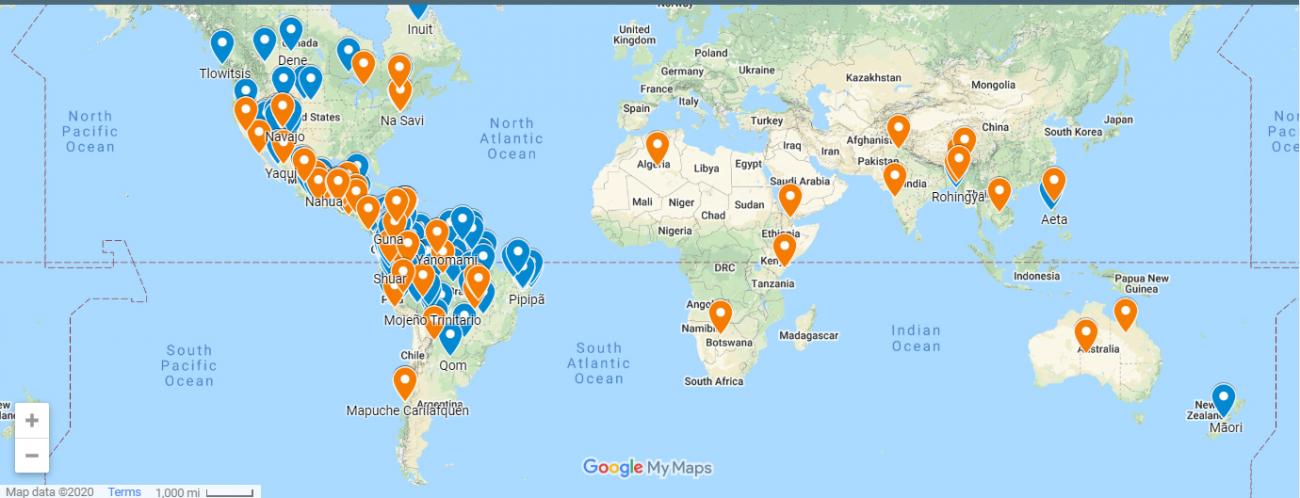|
En Español
"Indigenous Peoples historically have been excluded and erased from statistical data collection in many countries nationally and globally. This was done for many reasons including data suppression, negligence, and to simply withhold financial support for Indigenous Peoples. If not counted, we do not exist. The situation with the COVID-19 pandemic is not an exception. While being disproportionately affected by the pandemic, Indigenous Peoples are still struggling to be heard and receive support from their own governments. This is why we are taking matters in our hands in a self-determined way by collecting our own information and making sure we are no longer invisible," says Galina Angarova, Cultural Survival executive director.
Indigenous communities experience alarming rates of inequities and systemic discrimination, including limited to no access to information, holistic medical care, medical supplies, food, housing, and more. Additionally, Indigenous Peoples are nearly three times as likely to live in extreme poverty and likely to suffer negative outcomes from infectious diseases. Many Indigenous Peoples also experience disproportionate rates of malnutrition, pre-existing health conditions, and lack of access to culturally relevant information, quality healthcare, housing, and clean drinking water. There is a great need for disaggregated data as many State governments are not tracking COVID-19 infection rates by ethnicity or minority groups, but it is widely known and ignored that Indigenous communities and People of Color are disproportionately affected.
In addition to providing regular comprehensive programming, Cultural Survival has swiftly adapted to also provide emergency support to Indigenous Peoples who are being impacted by the COVID-19 pandemic, globally. Due to the need to present information disaggregated by Indigenous Peoples, Cultural Survival is curating the first global monitoring system for COVID-19 for Indigenous communities using Google maps technology to document COVID-19 cases and related human rights violations. Cultural Survival is producing this map to collect and disseminate information to show the situations Indigenous communities are facing as a result of COVID-19. As the number of cases increase daily, and the lack of access to testing in rural areas, the data presented will evolve over time.
Public health data focuses on cities and majority groups, not rural Indigenous communities, therefore, negatively impacting Indigenous Peoples access to resources. This technology will also enable Indigenous Peoples to share their own factual data, rather it being suppressed and controlled by governments and other institutions. This system enables Indigenous communities to track cases and human rights violations surrounding their territorial borders so they can best prepare and respond as they approach their communities.
Rural Indigenous communities are often intentionally not recognized by their governments, therefore do not have access to resources to support their self-determined responses to COVID-19 and ensure their communities are healthy, safe and well-informed of the daily changes of this virus. Recognizing these pre-existing and evolving barriers, we have responded by providing life-saving support, assistance and redistributing resources to the most vulnerable communities. Our Indigenous grant partners have informed us of the unique situations they are experiencing on the ground in their communities, how they are responding, and what is needed. We have a unique disposition to respond to their needs while simultaneously upholding Indigenous rights, and prioritizing health, well-being and cultural continuity during this critical time. As much of the world is being informed of what COVID-19 is and how it spreads, Indigenous Peoples are largely being left out of this conversation and this information sharing and their access to information is further complicated by language barriers. Public health information is not being made available in Indigenous languages, leaving Indigenous elders and rural communities behind, and uninformed on effective prevention measures.
This project is participatory and we encourage Indigenous communities to contribute information and data to the map. To date, we have identified 129 Indigenous Peoples from 185 villages/towns in 20 countries with COVID-19 cases.
View map here.
Disclaimer about the map:
Empty areas do not imply that there are no cases of COVID-19 or human right violations. This is a continuous and not exhaustive effort and we invite Indigenous Peoples and their communities to contribute.
We want to acknowledge the journalists and organizations that have been covering and sharing information on how Indigenous Peoples are impacted by the pandemic. We have tried to include links to all the source information in the map.
|

